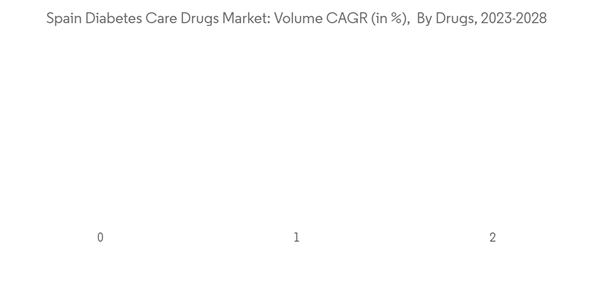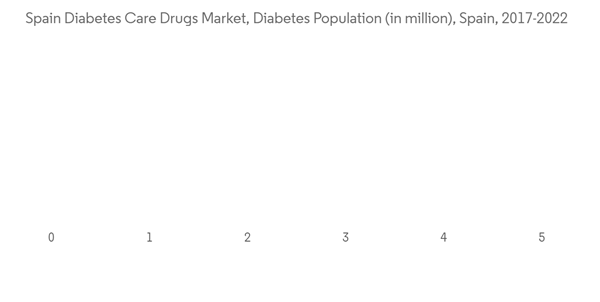The Spain Diabetes Care Drugs Market size is estimated at USD 1.21 billion in 2024, and is expected to reach USD 1.52 billion by 2029, growing at a CAGR of 4.5% during the forecast period (2024-2029).
Spain has According to WHO, 102,258,825 vaccination doses have been delivered as of June 25, 2022. Regardless of past diabetes history, entrance hyperglycemia is a significant predictor of all-cause mortality in COVID-19 patients who are not severely ill. Spain was one of the countries most hit by the COVID-19 epidemic in 2020. To contain the outbreak due to a rise in cases, a thorough national lockdown was enacted from 14 March 2020 to 21 June 2020. On October 25, the government declared a state of emergency in response to the resumption of cases following a nearly four-month period in which certain restrictive restrictions had been eased. This included partial lockdown measures with mobility restrictions, which would last until May 9, 2021. The COVID-19 pandemic in Spain has pushed the government to implement novel legislation and restrictions in an attempt to halt the virus's spread. Lockdown has been shown to be an effective approach for reducing the risk of infection. As a result of the aforementioned reasons, the expansion of the studied market in Spain is predicted.
Insulin Drugs are important components of type 1 diabetes management (T1D). Insulin drugs are examples of such drugs. These devices have been associated with improved glucose control and reduced hypoglycemia.
In terms of medicines, the insulin category commands a sizable market share. Over 100 million people worldwide use insulin, including all persons with Type 1 diabetes and 10% to 25% of people with Type 2 diabetes. Insulin production is extremely sophisticated, and there are only a few insulin manufacturers on the market. As a result, there is fierce rivalry among these producers, who are continually striving to satisfy the demands of patients by providing the highest-quality insulin.
Although enhanced glycemic management has been recognized for decades to lower the frequency of microvascular problems, empirical information addressing macrovascular consequences and mortality has been absent until recently. Some diabetic medicines have even raised concerns about their cardiovascular safety. Furthermore, the findings of trials comparing rigorous control (HbA1c6.5%) to standard treatment in patients with DM2 and a high cardiovascular risk have called into doubt the safety of the former method, as well as glucose-lowering medication in general, in DM2.
Although enhanced glycemic management has been recognized for decades to lower the frequency of microvascular problems, empirical information addressing macrovascular consequences and mortality has been absent until recently. Some diabetic medicines have even raised concerns about their cardiovascular safety. Furthermore, the findings of trials comparing rigorous control to standard treatment in patients with DM2 and a high cardiovascular risk have called into doubt the safety of the former method, as well as glucose-lowering medication in general, in DM2.
Through the Spanish government's encouragement, the usage of management devices increased over the forecast period.
According to the IDF 2021 report, diabetes prevalence in Spain reached 14.8%, or one in seven adults, the second highest rate in Europe. In addition, diabetes-related health expenditures in Spain reached 15.5 billion USD. Almost 30.3% of people living with diabetes in Spain were undiagnosed.
According to the Sociedad Espanola de Diabetes (SED), therapeutic education in diabetes has gone from being a necessity to becoming a priority and an urgency. The unstoppable increase in cases and the appearance of important developments in the control and management of the disease require, more than ever, training efforts accompanied by indispensable equity measures to facilitate the access of all people with diabetes to these new resources. The SED also recognizes the important progress made in the approach to diabetes, especially with technological advances. For example, the financing of Flash systems for people with type-2 diabetes on treatment with a bolus-basal insulin regimen has been approved.
When diabetes is undetected or inadequately treated, people with diabetes are at risk of serious and life-threatening complications, such as heart attack, stroke, kidney failure, blindness, and lower-limb amputation. These result in reduced quality of life and higher healthcare costs, leading to a greater need for access to care. Various pieces of evidence suggest that diabetes can be successfully managed, especially when detected early. Multifactorial intervention, including control of blood glucose, blood pressure, and lipids, can reduce the broad range of diabetes-related microvascular and macrovascular complications and premature mortality.
Thus, owing to the above factors, it is expected to drive market growth over the forecast period.
This product will be delivered within 2 business days.
Spain has According to WHO, 102,258,825 vaccination doses have been delivered as of June 25, 2022. Regardless of past diabetes history, entrance hyperglycemia is a significant predictor of all-cause mortality in COVID-19 patients who are not severely ill. Spain was one of the countries most hit by the COVID-19 epidemic in 2020. To contain the outbreak due to a rise in cases, a thorough national lockdown was enacted from 14 March 2020 to 21 June 2020. On October 25, the government declared a state of emergency in response to the resumption of cases following a nearly four-month period in which certain restrictive restrictions had been eased. This included partial lockdown measures with mobility restrictions, which would last until May 9, 2021. The COVID-19 pandemic in Spain has pushed the government to implement novel legislation and restrictions in an attempt to halt the virus's spread. Lockdown has been shown to be an effective approach for reducing the risk of infection. As a result of the aforementioned reasons, the expansion of the studied market in Spain is predicted.
Insulin Drugs are important components of type 1 diabetes management (T1D). Insulin drugs are examples of such drugs. These devices have been associated with improved glucose control and reduced hypoglycemia.
In terms of medicines, the insulin category commands a sizable market share. Over 100 million people worldwide use insulin, including all persons with Type 1 diabetes and 10% to 25% of people with Type 2 diabetes. Insulin production is extremely sophisticated, and there are only a few insulin manufacturers on the market. As a result, there is fierce rivalry among these producers, who are continually striving to satisfy the demands of patients by providing the highest-quality insulin.
Spain Diabetes Care Drugs Market Trends
Oral-Anti Diabetes Drugs is Having the Highest Market Share in the Current Year.
The oral anti-diabetic drugs segment is expected to increase with a CAGR of over 3.7% during the forecast period. Patients with type-1 diabetes (T1D) must maintain healthy lifestyle conditions, which depend on a person's personality traits, social interactions, socioeconomic circumstances, and environmental living factors. Continuous glucose monitoring (CGM) combined with multiple daily injections (MDI) has been found to reduce non-severe and severe hypoglycemia in people with T1D who are prone to this side effect. Patients with T1D at high risk of hypoglycemia could employ standalone continuous glucose monitoring to regulate their blood sugar levels, even in the terrible living conditions imposed by the COVID-19 pandemic crisis's draconian lockdown. The lockdown period was associated with a slight improvement in glucometric indicators, particularly those related to glucose exposure, which led to initiatives to lighten the load.Although enhanced glycemic management has been recognized for decades to lower the frequency of microvascular problems, empirical information addressing macrovascular consequences and mortality has been absent until recently. Some diabetic medicines have even raised concerns about their cardiovascular safety. Furthermore, the findings of trials comparing rigorous control (HbA1c6.5%) to standard treatment in patients with DM2 and a high cardiovascular risk have called into doubt the safety of the former method, as well as glucose-lowering medication in general, in DM2.
Although enhanced glycemic management has been recognized for decades to lower the frequency of microvascular problems, empirical information addressing macrovascular consequences and mortality has been absent until recently. Some diabetic medicines have even raised concerns about their cardiovascular safety. Furthermore, the findings of trials comparing rigorous control to standard treatment in patients with DM2 and a high cardiovascular risk have called into doubt the safety of the former method, as well as glucose-lowering medication in general, in DM2.
Through the Spanish government's encouragement, the usage of management devices increased over the forecast period.
The rising prevalence of diabetes in Spain is boosting the country's diabetes device market
In Spain, the diabetes population is expected to increase by more than 2.5% over the forecast period.According to the IDF 2021 report, diabetes prevalence in Spain reached 14.8%, or one in seven adults, the second highest rate in Europe. In addition, diabetes-related health expenditures in Spain reached 15.5 billion USD. Almost 30.3% of people living with diabetes in Spain were undiagnosed.
According to the Sociedad Espanola de Diabetes (SED), therapeutic education in diabetes has gone from being a necessity to becoming a priority and an urgency. The unstoppable increase in cases and the appearance of important developments in the control and management of the disease require, more than ever, training efforts accompanied by indispensable equity measures to facilitate the access of all people with diabetes to these new resources. The SED also recognizes the important progress made in the approach to diabetes, especially with technological advances. For example, the financing of Flash systems for people with type-2 diabetes on treatment with a bolus-basal insulin regimen has been approved.
When diabetes is undetected or inadequately treated, people with diabetes are at risk of serious and life-threatening complications, such as heart attack, stroke, kidney failure, blindness, and lower-limb amputation. These result in reduced quality of life and higher healthcare costs, leading to a greater need for access to care. Various pieces of evidence suggest that diabetes can be successfully managed, especially when detected early. Multifactorial intervention, including control of blood glucose, blood pressure, and lipids, can reduce the broad range of diabetes-related microvascular and macrovascular complications and premature mortality.
Thus, owing to the above factors, it is expected to drive market growth over the forecast period.
Spain Diabetes Care Drugs Industry Overview
The diabetes care drugs market is moderately fragmented, with few significant and generic players. The insulin and Sglt-2 drug markets are dominated by a few major players, like Novo-Nordisk, Sanofi, AstraZeneca, and Bristol-Myers Squibb. The market for oral drugs like sulfonylureas and meglitinides comprises more generic players. The intensity of competition among the players is high, as each player is striving to develop new drugs and offer them at competitive pricing. Furthermore, to increase their market shares, players are tapping into new markets, especially emerging economies where the demand is very high compared to the supply.Additional Benefits:
- The market estimate (ME) sheet in Excel format
- 3 months of analyst support
This product will be delivered within 2 business days.
Table of Contents
1 INTRODUCTION
4 MARKET DYNAMICS
5 MARKET SEGMENTATION
6 MARKET INDICATORS
7 COMPETITIVE LANDSCAPE
Companies Mentioned (Partial List)
A selection of companies mentioned in this report includes, but is not limited to:
- Takeda
- Novo Nordisk
- Pfizer
- Eli Lilly
- Janssen Pharmaceuticals
- Astellas
- Boehringer Ingelheim
- Merck And Co.
- AstraZeneca
- Bristol Myers Squibb
- Novartis
- Sanofi
Methodology

LOADING...










